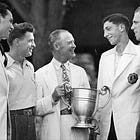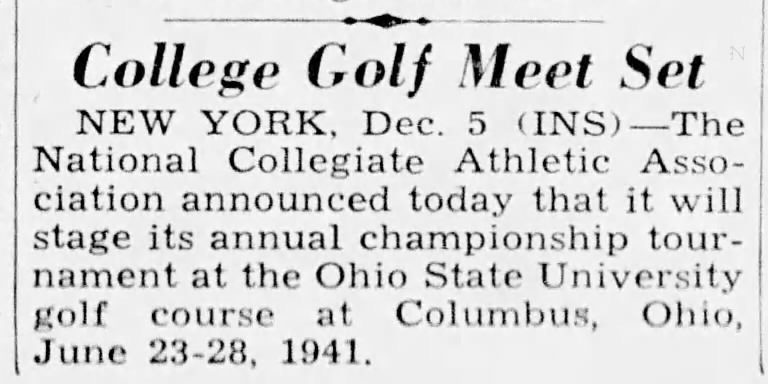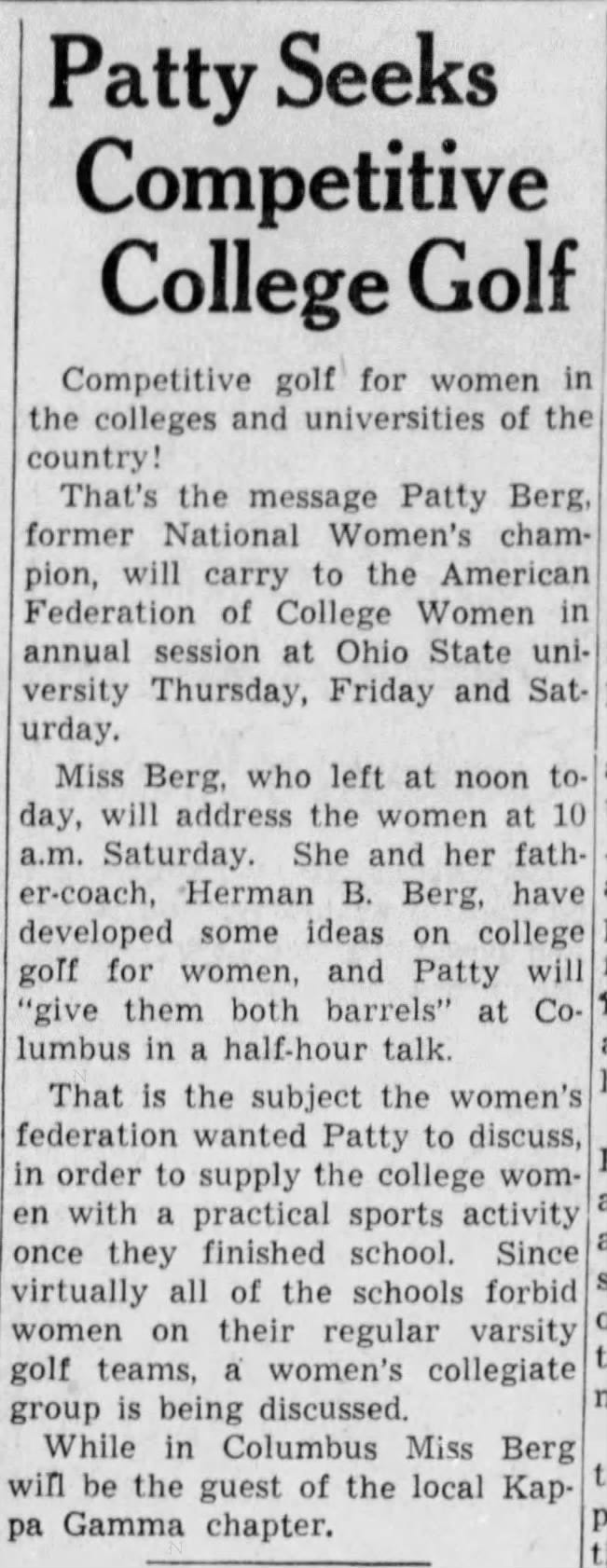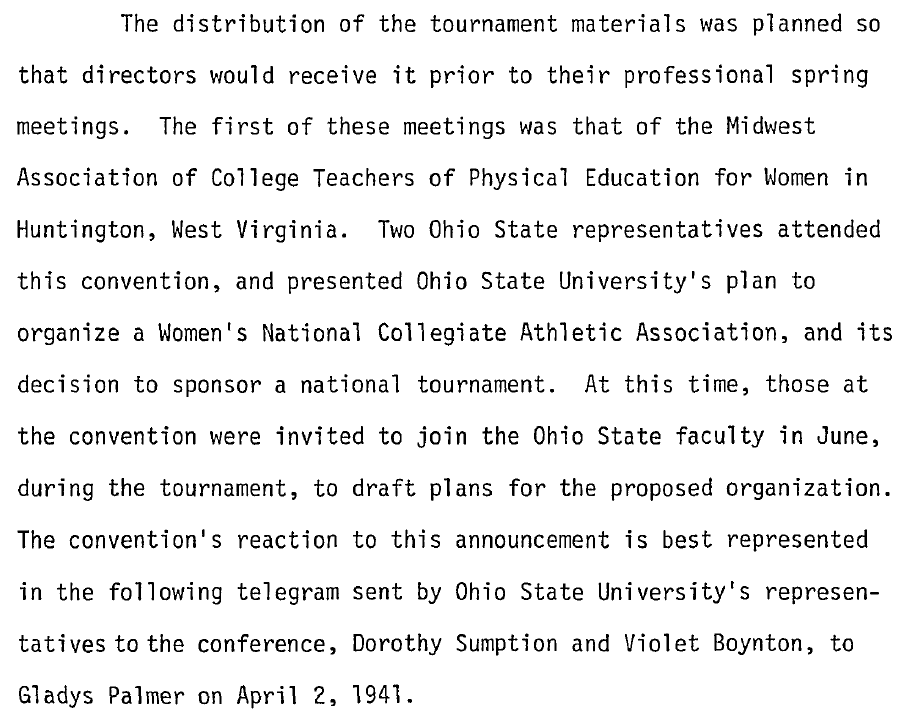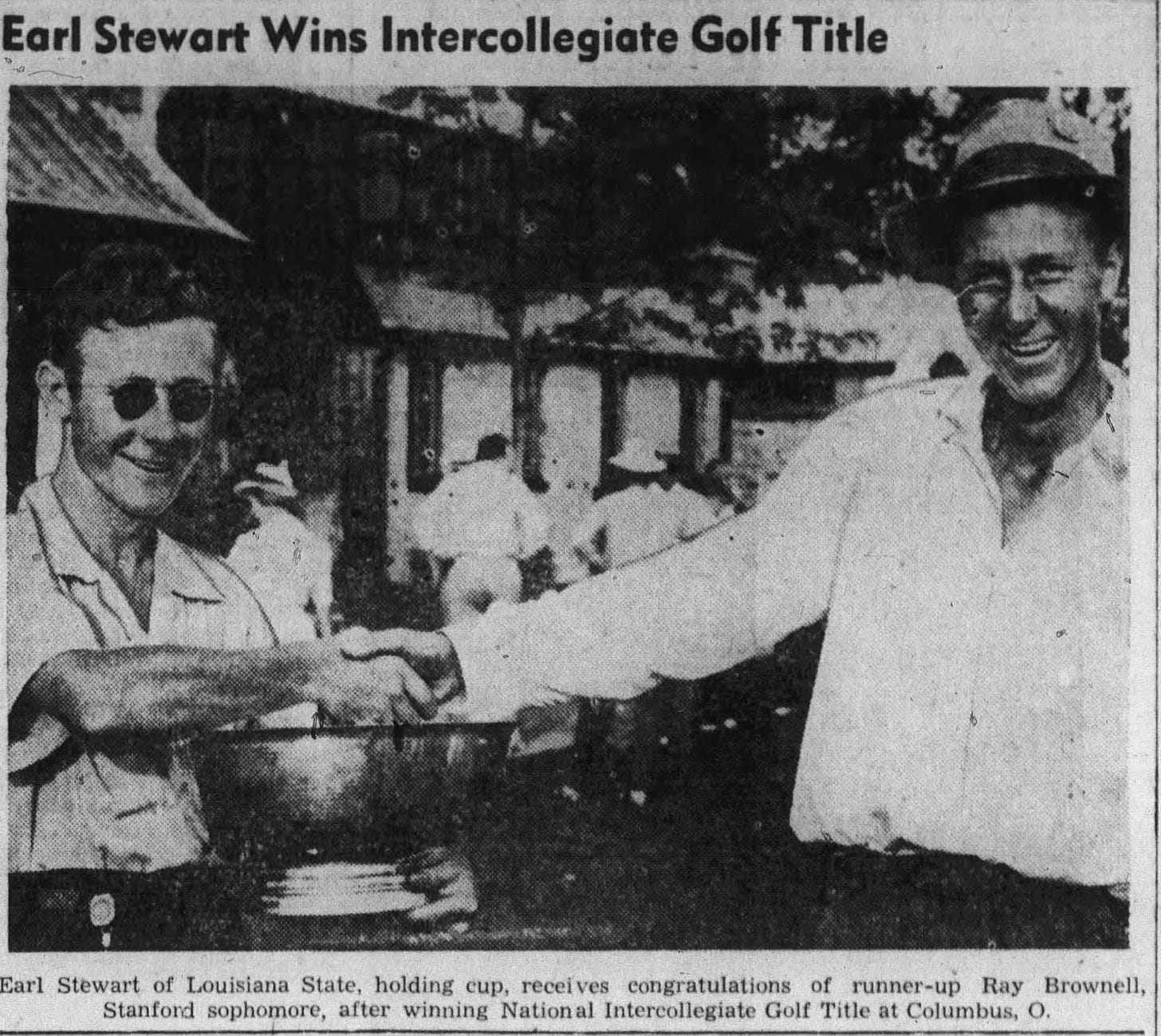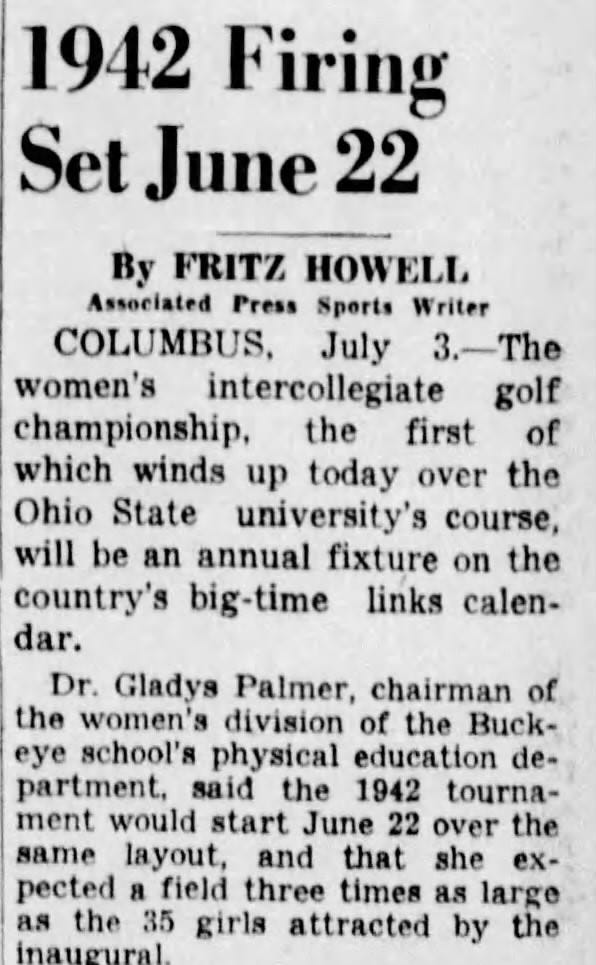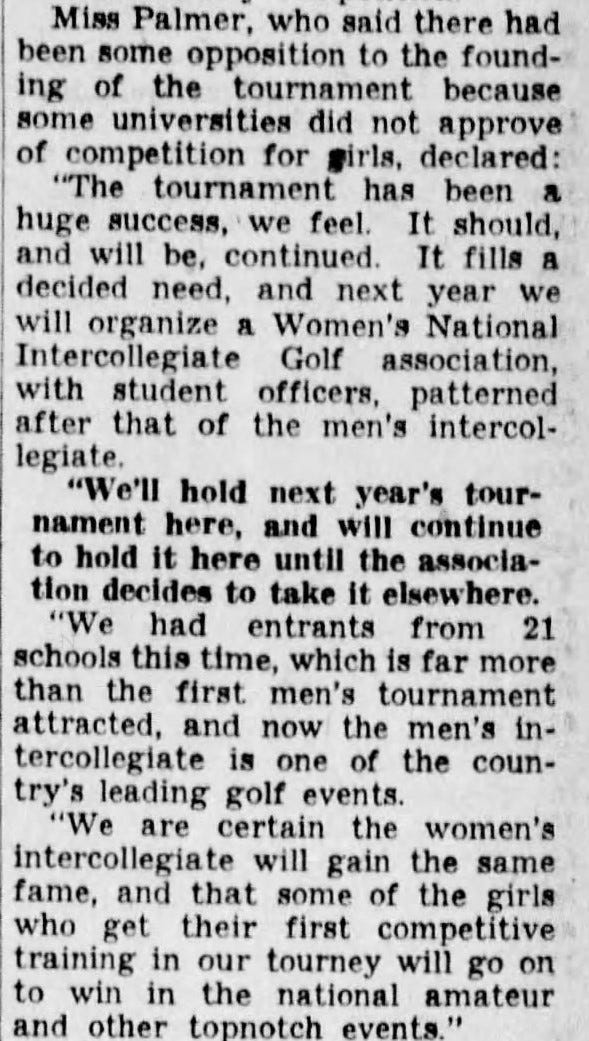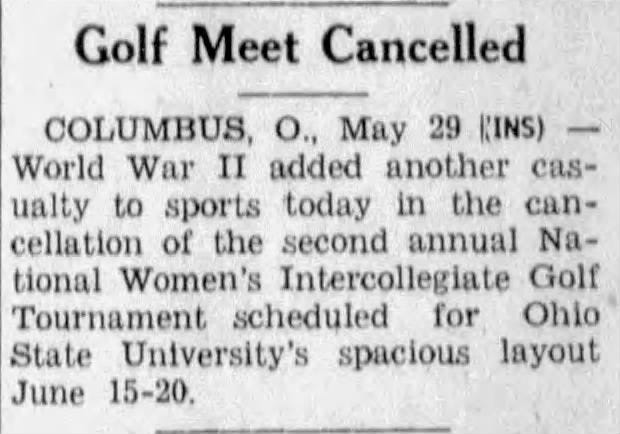1940-1941: OHIO STATE IS THE KEYSTONE TO WOMEN’S AND MEN’S COLLEGIATE GOLF
Shortly before the onset of WWII, a fascinating chain of events led to Ohio State becoming the literal linchpin for women’s and men’s collegiate golf by kick-starting the former and holding together the latter through the war years. In a very real sense, Ohio State hosting first the men’s (44th) then women’s (1st) championship in June-July, 1941 was a monumental turning point for collegiate golf. Today we explore some of the key events leading up to the championships and their historical significance.
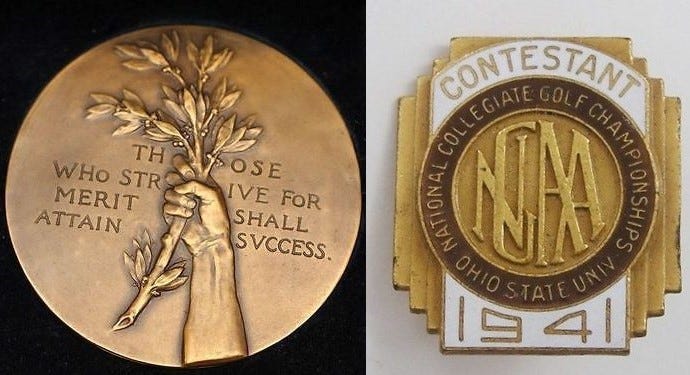
MAIN CHARACTERS
*NOTE: underlined text provides a link to references or sites with more information
There are many people mentioned throughout, so here are some of the main characters (in alphabetical order) to hopefully provide better context:
Bartlett Arkell - CEO of Beech-Nut Packing Company who was a well known philanthropist that donated a significant amount of time and money to his home course, historic Ekwanok County Club in Manchester, VT
Patty Berg - One of the most recognized women in golf history, Berg was an incredible amateur player who left the University of Minnesota to turn professional in 1940, was one of the original LPGA Tour founders and its first president (1950), and went on to accumulate 60 LPGAT victories which all earned her entry into too many Halls of Fame to count
Leslie Cooke - Well-known and respected member of the Western Golf Association (WGA) who was the current President of the organization during this time (1939-41) and member of the USGA Executive Committee
Chick Evans - One of the most celebrated amateur players of the 1910-30s era, Evans is often recognized for being the first player to win the US Amateur and US Open in the same year (1916). Among his many accomplishments on the course, which includes both USGA and WGA championship victories, Evans would later become the first NCAA Golf Championship Committee Chairman and help usher in a new age of intercollegiate golf
Gladys E Palmer - Directly from her Ohio State bio: “Gladys Palmer was a trailblazer in women’s athletics, pioneering the first national championship for all of women’s collegiate sports. In the 1940s, Palmer was the chairwoman of the women’s division of the Physical Education Department at OSU.”
Lynn Wilbur St. John - After a distinguished coaching career in football, basketball, and baseball in the early 1920s, “The Saint” St. John became the athletic director at Ohio State
Jess Sweetser - Before serving in the USGA as treasurer and member of the executive committee, Sweetser was a decorated amateur player whose major victories include the 1920 individual Intercollegiate championship [Yale], 1922 US Amateur, and 1926 British Amateur
Mary Yost - Instructor in the Ohio State Physical Education department and later professor whose recollections and saved materials were crucial primary resources for a number of dissertations on the topic of early women’s intercollegiate sports
GENERAL TIMELINE
Keep this timeline in mind when we go through everything below, first on the men’s side then the women’s side of thing:
June 1939 - First NCAA men’s golf championship
Dec 1939 - Ekwanok CC announced as host for 1940 NCAA championship
Apr 1940 - Patty Berg gives speech at AFCW hosted by University of Ohio State
May 1940 - Ohio State course(s) officially open with ceremonial match that includes Patty Berg
May 1940 - Ohio State hosts Big Ten championship
Fall 1940 - Ohio State creates stand-in organization tentatively called the Women’s National Collegiate Athletic Association
Dec 1940 - Ohio State course announced as host for 1941 NCAA championship
March 1941 - Ohio State announces plans for Women’s National Collegiate Golf Tournament
Apr 1941 - Unfavorable reactions to golf tournament plans at multiple women’s conferences
May 31 1941 - Deadline for entry into first Women’s Intercollegiate Golf Championship
June 1941 - Ohio State hosts men’s NCAA championship
June 1941 - Ohio State sponsors/hosts women’s championship
MEN’S SIDE
First NCAA Golf Championship (1939)
The first 41 men’s championships were run by a combination of the student-run body of the players themselves, called the Intercollegiate Golf Association (IGA), and the USGA. In early 1939, the two organizations came to terms with the NCAA to turn over primary responsibilities for running the annual championship, but offered a crucial partnership so that all three bodies could effectively manage the large tournament. It was an important step in the evolution of the men’s game in a way that would pay off quickly - persisting through the war years when all of the USGA championships were put on hold - but also introduced some interesting challenges. Legendary amateur player Chick Evans, who was drawing near to the end of his competitive career, stepped into a new role as the first NCAA Golf Committee Chairman, selecting Wakonda Club in Iowa as the site for the 1st NCAA (42nd overall) men’s collegiate golf championship.
For a more detailed account of the first NCAA men’s golf championship, check out this post from out Men’s Championship series:
Controversy Selecting the 1940 Championship Site
More than 200 players from teams across the country participated in the 1939 championship, and excitement for the 1940 championship was at an all-time high. The championship was slated to return to Ekwanok CC (Vermont), which had hosted only one time prior, in 1912. The campaign to bring the collegiate tournament back to Ekwanok was masterminded by the charismatic CEO of the Beech-Nut Company, Mr. Bartlett Arkell, who had done much for his home club over the years. The tournament he helped put on in 1940 was another huge success for the NCAA and Arkell left his lasting legacy with the donation of the (now lost) “Chick Evans Bowl”, a perpetual trophy awarded to the individual champion each year to (literally) etch their name in history.
The only problem with this rosy picture is one major inconvenient truth: the championship had apparently been promised to another club, Hartford GC (Connecticut). It seems that perhaps Mr. Arkell had altered the plans by offering something (like maybe a new ~$2k trophy) to change the minds of Chick Evans’s golf committee. At worst this was a bad look for the NCAA (the irony not being lost on this author), even still it earned a rebuke from the USGA and likely played a pivotal role in how championship sites were selected going forward.

The “Mr. Cooke” mentioned above is none other than Western Golf Association (WGA) President (1939-40) Leslie Cooke, who is referencing the fact that recent Western Junior championships were held at the University of Minnesota (1938) and Michigan (1939) courses. Although we don’t have details of the letter that Mr. Jess Sweetser sent to Mr. Chick Evans, it’s not hard to connect the dots from that (undoubtedly strong) message to the next series of events.
Super fun bonus facts: Jess Sweetser defeated Chick Evans (3&2) in the 1922 US Amateur Finals, held at The Country Club in Brookline. They met again during the 1923 Western Amateur, where Evans def Sweetser (38th hole) on his way to winning his 4th Western Am in a row. These were two of the biggest amateur golf events in the country!
Opening of Ohio State’s Course [18 May 1940]
A month and a half before the championship at Ekwanok, Ohio State’s much anticipated courses opened to great fanfare with a dedication ceremony that included an interesting foursome exhibition match consisting of Robert Kepler (Ohio State golf coach), Blanche Sohl (member of Ohio State physical education staff), Chick Evans, and Patty Berg (celebrated young women’s national amateur champion). Ohio State hosted the Big Ten championship at the Scarlet course the following week, proving the venue was suitable for big time collegiate events.
Selecting the 1941 Championship Site [5 Dec 1940]
Buried among the various newspaper reports covering the 1940 championship is a small blurb speculating that Ohio State’s course(s) had already been chosen for the 1941 championship and that Stanford’s course may be next. Although they would not be the first college team to act as the tournament host, Ohio State would become the first to host the championship on their own University owned/run course. This set a precedent that effectively put an end to the use of courses not run by or otherwise closely affiliated with the host university, thus ensuring the events like the 1940 selection wouldn’t be repeated. This decision was an important moment for the men’s tournament, but few could have predicted the ripple effect it would have on things such as the not-yet-existing women’s collegiate golf championship.
WOMEN’S SIDE
Brief History up to late 1930s
It’s likely not surprising that women’s college athletics was practically non-existent in the 1930s, however, the notion of an organized body for women’s collegiate golf goes back practically as far as the men’s organization! After the success of the men’s IGA in organizing a yearly tournament starting in 1897, there was talk of forming a women’s IGA. This newspaper clipping from 1900 indicates the thinking of the time as to why a women’s IGA didn’t come to fruition.
The history of women’s collegiate athletics leading up to WWII is unfortunately too complex to properly explore here, but suffice it to say that opportunities were few and focused primarily around physical education rather than competition. For the most part, women seeking competitive golf would do so individually at their home clubs or in various regional and (few) national tournaments. There were, however, a few women in the 1920s and 1930s who made newspaper headlines when attempting to play for their college/university’s men’s team. Most were met with strong “discouragement” or outright bans, such as Wisconsin phenom sophomore Dorothy Page who was effectively banned from playing in 1928 despite there not being any explicit rule against her playing on the men’s team. It’s very important to note here that a decent bit of the opposition came from female educators who strongly believed women shouldn’t be competing with men.
A few select players, however, did manage to clear the hurdles and a couple even officially earned varsity letters. Some of those women include Ruth Tustin who earned her Oregon “numeral” (freshman team) in 1938, Janet Shock who not only played on the varsity team in 1938 but also helped Dennison win the Ohio Conference title, and Eva Shorb who played in a few matches for Wooster (one against Janet Shock) and would later pass on her golfing prowess to her son, Tom Weiskopf!
By the mid-late 1930s, a number of colleges had loosely organized women’s teams who would compete in a handful of matches a year, usually against nearby colleges or clubs. In October, 1939, the University of Penn, one of the original 5 colleges to start the men’s championship 40 years before, tried to get things going with a women’s tournament held at Philadelphia Cricket Club with representatives from schools such as Penn, NYU, Penn State, Elmira, Beaver, Temple, and Swarthmore. The tournament was successful enough that they were able to have a second the following October (1940), however that appears to be the last one they hosted until after WWII. The time seemed right for an actual national championship, but the enduring major problem was the lack of an official organized body to create and promote such a tournament.
Patty Berg Speaks to American Federation of College Women at Ohio State [20 April 1940]
Perhaps one of the most crucial events in the history of women’s collegiate golf occurred off the course in the spring of 1940. One of the best female players in the country at that time was a young University of Minnesota student named Patty Berg who did two very important things in the Spring before dropping out of school in the Fall to turn pro. The second thing was her participation in the ceremonial foursome match for the Ohio State University course mentioned above. A month prior to that, Ms. Berg delivered an impassioned speech on the need for competition in college women’s athletics to university representatives of the Northeastern Section of the American Federation of College Women who just happened to have their annual meeting in Columbus, Ohio. One of Patty’s main points was that she felt she would be able to persuade the USGA to sponsor a tournament for college women, which, while obvious given their history of sponsoring the men’s collegiate tournament the previous decade, not as likely now that they had effectively passed off primary responsibilities of that tournament to the NCAA.
One of those in attendance for Ms. Berg’s speech was Ohio State’s Chairman of the Women’s Physical Education Division, Gladys E. Palmer, who made it a point to talk with her afterwards. Like many other universities in the 1920s-30s, Ohio State had a physical education program with specific department members and educators who utilized women’s sporting activities as a part of that education. What set Ohio State apart from most programs at the time was a philosophy that competitiveness in women’s athletics was not a bad thing and that the highly skilled competitors in any given sport were languishing in an environment that emphasized participation by all over excellence. In short, the common philosophy was of the we’re-not-keeping-score-and-everyone-gets-a-participation-trophy type. Patty Berg was a passionate and vocal representation of the competitive collegiate women who sought to break this trend, which resonated with Ms. Palmer as a representative of the entire Ohio State women’s physical education staff. Another important member of that staff, Mary Yost, would recall in an interview the next year:
During the past year the members of the Department of Physical Education of The Ohio State University have given a great deal of thought to Miss Berg’s speech, and have decided that the organization and administration of competition for women college students should be in the hands of trained women in the field of Physical Education.
Ohio State staff pushing for Women’s NCAA and Announcing a Women’s Collegiate Golf Tournament
It’s important to understand that many men’s collegiate athletics had largely developed their regional and later national organizations alongside the sport itself. This was the case for golf and the IGA which gained significant help from the USGA some 30 years after the tournament’s creation and then eventually tied in with the NCAA which itself had started well after college football, baseball, and other sports had started serious competitions and even championships.
Conversely, there were already many many well-established regional and national women’s collegiate organizations by 1940, several with varying degrees of concern with women’s athletics. The one thing they all had in common was strong conflicting opinions on how to handle female competition. In fact, over the course of several years prior to Patty Berg’s speech to one of these organizations, Gladys Palmer had already written several papers and given a few speeches herself in front of other organizations. Ms. Palmer’s presentations seemed to have been more practical than passionate in nature, but ultimately ran into the same bureaucratic trap of “we’ll start thinking about maybe looking into that in the future” as Ms. Berg’s speech.
By the Fall of 1940, the Ohio State staff seems to have become convinced that a national organization needed to be created which would provide strict and direct leadership of women’s intercollegiate competition, and that this should be under the guidance of female physical educators rather than other women’s organizations or even male athletics. In essence, they felt they needed a Women’s National Collegiate Athletic Association which would govern the likes of archery, bowling, badminton, tennis, table tennis, riflery, fencing, swimming, and golf. An incident later that year involving a highly skilled female rifle shooter (Helen Jenkins1) looking to join the men’s team due to lack of organized female competition forced Palmer to put on paper all of the reasons why women should be competing against other women, and was one of the final catalysts towards Ohio State simply creating the WNCAA with a stand-in constitution and guideline for future meetings when they could get others to join.
Given the entire purpose of the new organization was intercollegiate competition, naturally the first thing to organize was an athletic tournament. Connecting all of the golf-related dots up to this point along with the social acceptability of golf, we finally arrive at Ohio State’s decision in early 1941 to host a first-of-its-kind women’s national collegiate golf tournament on its home course just a few days after the conclusion of the men’s national tournament. Palmer and team created tournament “blanks” - essentially an informational brochure and signup sheet to be filled out and mailed back - and sent out their materials to colleagues in universities across the country in early April 1941.

To say this announcement was not well received would be a massive understatement. Later that month, Palmer and others went to the National Association of Directors of Physical Education for College Women (Atlantic City) where they were basically shunned. Below is a detailed excerpt of what went out across the nation around this same time.

Tournament built, but would the players come?
Gladys Palmer and crew were not deterred by the visceral reaction they received from their colleagues, and as Mary Yost recalled:
As alluded to above, they received few entries as the end of May deadline approached, but it turns out not to be a lack of interest by the players, rather there was an issue with the various college administrators passing down word of the tournament to the prospective players. Eventually, through a great word-of-mouth effort by several key people including Ohio State’s Athletic Director L.W. St. John - who was a huge advocate for what his staff was endeavoring towards - they managed to get word to the players and get needed eligibility proof a different way. To the relief of all, enough last minute entries poured in from across the country to justify proceeding with the tournament.
THE 1941 CHAMPIONSHIPS
44th Men’s NCAA Championship [June 23-28]
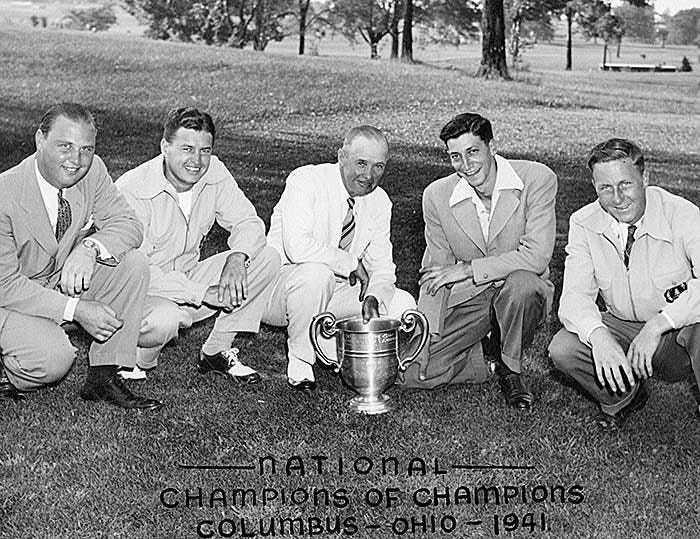
The 1941 men’s NCAA championship went off without a hitch, and was by any measure a great success. Stanford gained their third team championship in four years, and had one of their top players finish runner-up in the individual match play portion after the team stroke play (and individual qualifier for match play).
The FIRST Women’s Collegiate Golf Tournament [June 30-July 3]
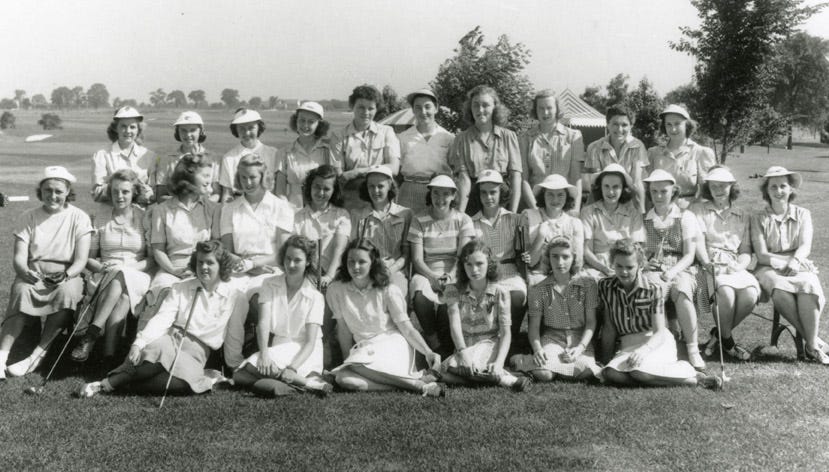
The women’s tournament began immediately after the conclusion of the men’s tournament, using a scaled-down version of the same format. There were only a handful of universities represented by more than one player, so the team championship, won by Rollins College, went to the best two-woman “team.” The individual stroke play scores were used to organize the players into multiple match play “flights” with the winners in each of those flights earning a specially-chosen bronze medal with the inscription “Those who strive for merit shall attain success.” Patty Berg was on hand to serve as the honorary ref for the finals match in the championship flight where Alabama senior Eleanor Dudley - former Illinois state and Western Junior champion - defeated Stephens College freshman Eddell Wortz to become the first women’s intercollegiate golf champion.
The Aftermath
Just like the men’s, the women’s tournament was by every measure a great success, and Gladys Palmer immediately announced plans for a second annual tournament for next year. The excitement was palpable as Palmer also announced plans for a brand new trophy named after its donor and the woman crucial to making the whole thing happen - the Patty Berg Trophy. A few months later, however, a surprise attack at Pearl Harbor changed everything. The country went to war and although the men’s NCAA golf tournament managed to stay alive throughout the war years (down to just 5 teams in 1944 and 1945, Ohio State being one of them), the women’s tournament did not.
It was finally revived in 1946, again with Ohio State acting as both host and main advocate. The University continued to host and grow the tournament through 1952. That’s when things got really interesting...
Want to know more about the beginning of the women’s collegiate golf? Curious about the twists and turns (and legal battles) that brought the tournament under the guidance of the NCAA in 1982? We hope you’ll join us by reading our upcoming women’s championship series in honor of the 80th playing at the conclusion of the 2023-24 season.
Helen Jenkins first attended Denison before transferring to Ohio State in 1940. While at Denison in 1938-39, she and Janet Shock were both members of a group created to discuss women’s athletics. The coincidence of these two women playing different sports at a different school and being linked to the creation of the golf tournament at Ohio State is pretty remarkable.




